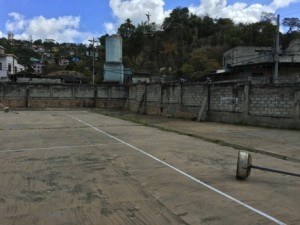
Photo taken during a recent security assessment site visit in Trinidad – Tobago. ©2016Michael Dorn Safe Havens International
This high school courtyard in Port of Spain, Trinidad is surrounded by a twelve foot concrete block wall. Note the multiple rolls of razor wire on top of the wall. Two students were recently murdered as they exited the main gate of the school at the end of the school day. The murder rate of 28 per 100,000 people in Trinidad – Tobago is well above the 3.2 murders per 100,000 in the United States.
It is easy to assume that American schools are uniquely challenged with violence and other safety concerns. In reality, school safety and security issues are a pervasive global issue. School officials in Canada, Mexico, Honduras, Guatemala, Argentina, Israel, the United Kingdom, Vietnam, South Africa, Kenya, and Trinidad – Tobago all have safety concerns ranging from poisonous snakes, spiders and centipedes to gang violence, terrorism and devastating natural disasters.
Hazards come in many forms and vary from country to country. For example, school-related homicides in many other countries typically occur “at the gate” instead of in the classroom or campus proper. England, Vietnam and Trinidad – Tobago are just a few examples of countries where schools are typically completely fenced in. Schools in Vietnam and Trinidad – Tobago also usually also have uniformed security personnel stationed at the entrance of both primary and secondary schools. In these countries, murders of students and staff typically occur right after the victim steps through the main entry gate to leave the campus rather than inside the compound. While working on a project in London in 2003, metropolitan police informed me that six students had been murdered at the gates of London K12 schools that year. Keeping in mind that there are more K12 students in the United States than there are people of all ages in England, six student homicides is a staggering number in relation to the overall population of the country.
It is extremely difficult to contrast school homicide data between countries due to differences in definitions and reporting practices. The United States is one of the only countries where the government actually tabulates school homicides at the national level. Currently, researchers often must comb through media accounts to find anecdotal data when trying to evaluate school violence in other nations. In addition, the homicide rates of many countries are far higher than in the United States. For example, United Nations data indicates an astounding 90 homicides per 100,000 people in Honduras in contrast to 3.2 homicides per 100,000 people in the United States. Venezuela currently ranks second in the world with 82 homicides per 100,000 people according to U.N. figures.
While many people assume that American K12 schools are among the most dangerous in the world, the educators in Trinidad – Tobago that I have worked with have been stunned to learn that Canada, England, Scotland, Sweden, Germany, Australia, Japan, Vietnam, Thailand, the People’s Republic of China, the Philippines, Austria, Germany, Mexico, Jamaica, the U.S. Virgin Islands, the Dominican Republic, Puerto Rico, Argentina, South Africa, Nigeria, Kenya, Pakistan, and most other countries around the globe have also experienced school-related homicides.
For perspective, it is also important to note that like the U.S., incidents of violence are not the only cause of mass casualty loss of life in schools abroad. For example, more than 7,000 Chinese students died in their schools during the Sichuan Earthquake in 2008. In an even more catastrophic event, another 17,000 students were killed in their schools in the 2005 earthquake in Pakistan. This week, I am working on a large school safety, security, climate, culture and emergency preparedness assessment project in India which has its own unique concerns about school safety. In one incident, a school teacher, a school custodian, and the school’s principal were arrested for criminal negligence after a young child who was not being properly supervised entered a maintenance access door that had been left unlocked. The boy drowned in a tank of water triggering actions by government official to hold school employees accountable for the child’s tragic death. Sadly, America is far from alone in our concerns of school safety and violence.